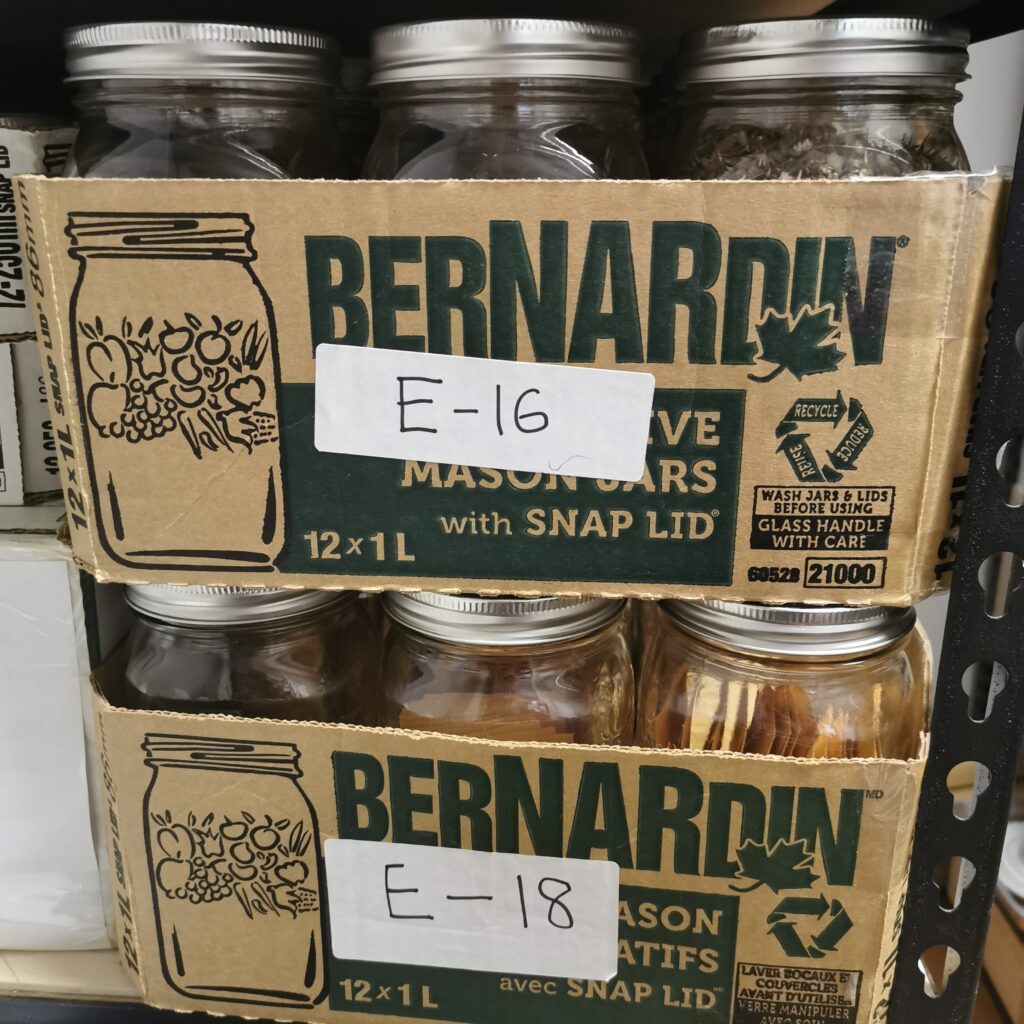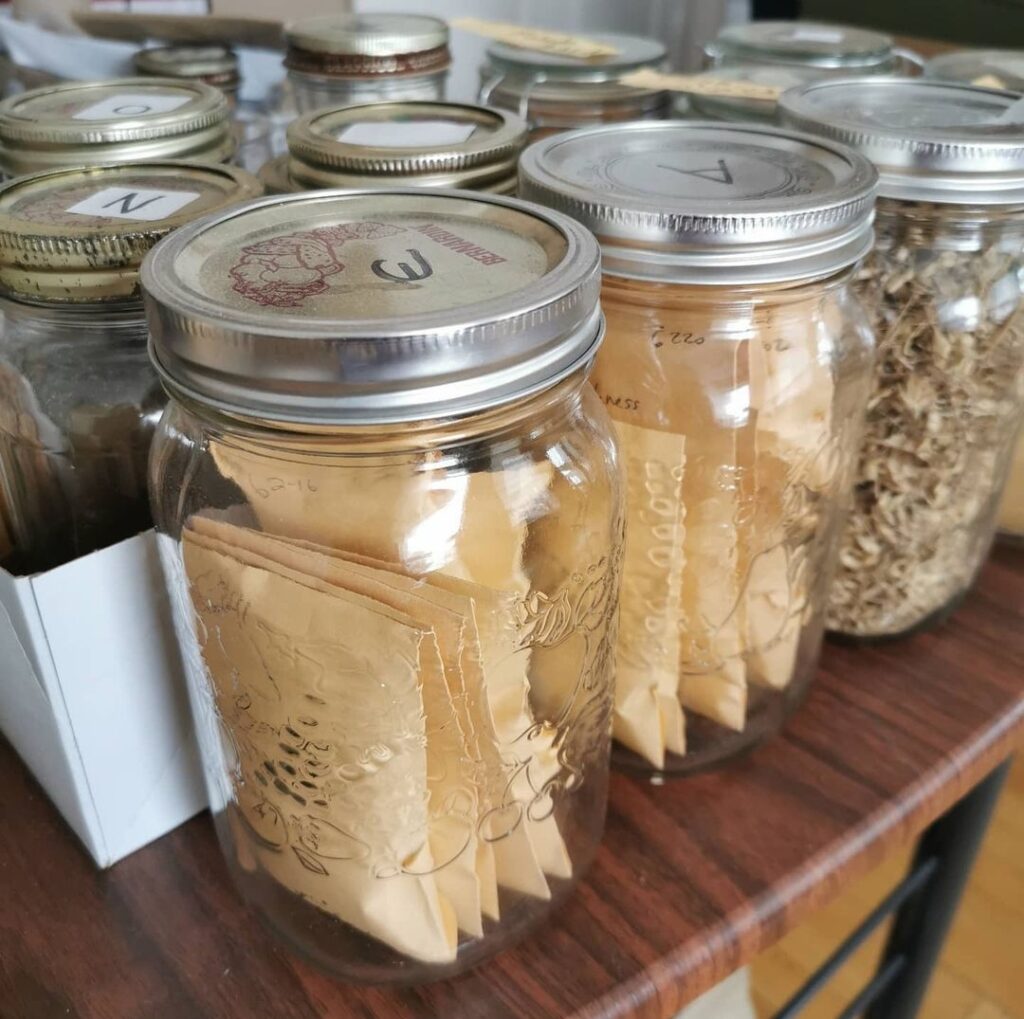You want to make sure that any seeds you have are properly stored so they will germinate when needed. Once your seeds are cleaned and well-dried, package them into airtight containers.
Snap top mason jars are excellent for seeds, though glass jars with thicker rubber seals and metal clasps make a better seal for long term storage.
Tip: Remember that many seed envelopes can fit inside one jar!
By packaging the seeds on a dry day, or by running a dehumidifier in the room (bringing the relative humidity down to 35% or lower), you can effectively decrease the amount of moisture in the jar. Once sealed, do not reopen the jar as this will immediately equalize the moisture in the jar with that in the surrounding air!


How does storing seeds work?
Seeds are living things, each with a little baby plant sleeping inside and stored food to feed that plant until it sprouts. That's the key to a seed's shelf life - it lives until it runs out of food. Old seeds don't grow because they ran out of food.
In other words, to make seeds last longer, it's important to make them consume their stored food more slowly. The deeper they sleep, the slower they eat, and the longer they live.
So, make them "dormant".
What makes a seed dormant?
Precisely the opposite of what makes them sprout.
| To germinate seeds | Moisture triggers seeds to grow | Warmth triggers seeds to grow | Light is needed by some seeds to germinate |
| To store seeds | Dry air puts seeds to sleep | Cold makes seeds consume food slowly | Darkness helps keeps seeds dormant |
NOTE: Dry is most important, followed by cold and then darkness.
Seed storage is not difficult, but it makes the difference between seeds that last for years, and seeds that refuse to sprout after only a few months.
Here's a simple trick for choosing a good place to store your seeds:
Measure the temperature in degrees Fahrenheit, and the percentage of relative humidity. If the sum of those numbers is less than 100, you've found a pretty good place to keep seeds in the open air.
°F + %RH < 100
The lower the temperature the better, and especially the lower the humidity the better, so try these methods:
- Put your well-dried seed in air-tight jars, and store the jars in a in one of the locations indicated below.
- Put an envelope of silica gel (a material that absorbs moisture) and an envelope of seeds in a sealed jar for two days. The silica will remove excess moisture from the air and also from the seeds. Remove the silica to prevent over-drying, and keep the seeds sealed in the dry jar for years.
Exactly how long your seeds will last depends on many variables. Generally, bean seeds usually last for 3-5 years if they're dry and room temperatures, tomato seeds can live for up to 10 years in the same conditions, and other vegetable and flower seeds normally keep somewhere between 2-6 years.
Here are some tips to get you thinking about seed storage:
- Every 6°C (about 10°F) of lower temperature will double a seed's lifespan (at typical temperature ranges).
- Every 1% of moisture removed from a seed will its lifespan (to a certain point - you can fatally overdry them by using heat)
- Seeds dried in silica gel, or very dry open air, will not be damaged by freezing. Then you can really make them dormant!
- Remember to keep seeds in air-tight jars, because the humidity is higher than you think.
Where to Store Your Seed Containers
Here are six good and bad places to store your seeds during the winter.
In the basement. (NO)
Usually, basements are fairly humid. Even if they are finished, most basements don't have the same ventilation as the upper floors of a house so moisture from the walls can enter the air.
In the fridge. (NO)
Fridges are cold, but they are also very wet and humid and therefore don't make great places for storing seeds. Even chilly seeds will expire fairly quickly if kept in such a humid place.
In a heated garage. (NO)
Though perhaps a convenient place to keep seeds, they unfortunately tend to have pretty severe temperature fluctuations at the door(s) are opened and closed in everyday life. This leads to condensation on all surfaces, including the seeds.
In air-tight containers in the basement. (YES)
Even if the basement is a bit humid, the dry air inside the containers plus the cool downstairs temperature should help the seeds to last. Glass jars are ideal for this, after the seeds have dried for at least a month.
In a main floor closet. (YES)
The main floor of the house might not be as cool as the basement, but it is almost certainly drier. Since dry is more important than cold, a dry closet is a really good place.
In an unheated garage or shed. (MAYBE)
Sometimes, an unheated garage of shed is a good place since changes in temperature are gradual outdoors. For this, ensure the seeds are completely dry and in glass jars.
There are a lot of places where you can store seeds successfully, as long as you focus on DRY, COLD, and (to a lesser degree) DARKNESS.
Learn more about saving seeds, and how to dry each species in our handbook "How to Save Your Own Seeds".
**
